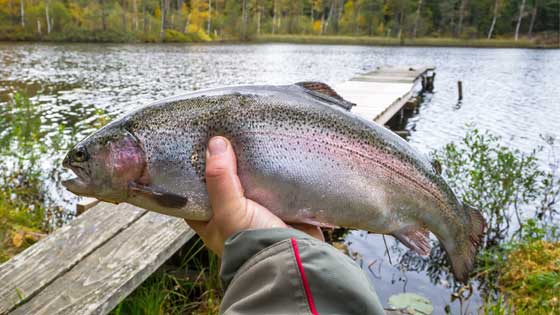Rainbow Trout Autumn Fishing

Rainbow Trout can be can be caught all day. The prime times being in the morning or the evening in rivers and streams.
They can also be caught throughout the water column in lakes during much of the Autumn months.
At the beginning of Autumn, the surface is much warmer than the rest of the water column which drives the Rainbow Trout towards the bottom. As fall progresses the water cools leaving the water temperature consistent throughout the water column. At this time, Rainbow Trout can be found throughout the water column feeding on schools of bait fish.
Toward the end of fall, Rainbows move to the bottom where the water is warmer than the rest of the lake.
Rainbow Trout can be caught using lures, baits and flies during the fall months. Flies offer the most enjoyment when fished from rivers and streams.
Best flies in Autumn
While some claim that any color fly will work, we recommend sticking to bright red or yellow flies. These will help focus the Rainbow Trout’s attention after they hear the fly hitting the water and help elicit a strike.
There are many good flies to try for the fall season. A Mickey Finn Woolly Worm with a streamer #2 to #6 having a tail that is red or yellow. A red body with wool or chenille is recommended.
Marabou flies in red or yellow work well that are capable of flashing like a woolly bugger. A deer hair bug is also very effective.
Fly fishing for Rainbow Trout
There are 2 methods of fly fishing for Rainbow Trout. Both methods are correct but only when used with the right conditions.
1.If the Rainbow Trout are feeding off the bottom of the river
Cast your marabou nymph about 2 to 3 feet from where they’re feeding, just past them. Gently jerk on the rod to make the fly move ever so slightly. The goal is to attract the attention of the Rainbow Trout so small jumps are important
2. If the Rainbow Trout are not feeding off the bottom
Fan cast your fly so that it hits the water with a popping sound. It’s this sound that will get their attention. They think it’s some sort of insect hitting the water.
Lure Casting for Fall Rainbow Trout
Many new anglers are surprised to learn that lure fishing is different from bait fishing on so many points.
- Your rod should not be much longer than 6 feet. The length of the rod does nothing to improve your chances of catching Rainbow Trout. It’ll just help prevent your arms from getting sore from repeated casts.
- Line strength need not exceed 8 pounds with 6 pounds being the better option. Fishing with a 2lb test line is not recommended for lakes where there’s many large fish which could easily snap a line with a test of 2 to 4 pounds.
- Spinners and spoons have proven very successful since they were introduced. The reflection of light is designed to resemble that of a wounded baitfish.
These lures are essential when fishing in lakes that are not clear or at night. The light reflected helps the Rainbow Trout locate the lure much easier.
Lures shouldn’t be much better than 1/3 of an ounce and nothing smaller than 1/8 of an ounce.
Hook size of 4 to 6 will work fine.



